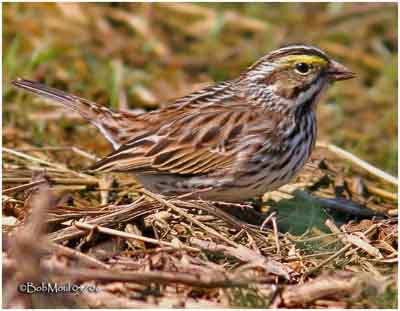
Savannah Sparrow
Passerculus sandwichensis
Passeriforme Order – Passerellidae Family
BIOMETRICS:
Length : 11-15 cm
Wingspan : 20-22 cm
Weight : 15-28 g
LONGIVITY: Up to 6 years
DESCRIPTION:
Savannah Sparrow is a small song bird. The most useful features are the yellow lore and fore-supercilium, and the bright pinkish legs. Yellow on lore/supercilium varies, being very pale and inconspicuous in some populations, especially in fresh plumage in autumn.
Overall coloration varies from sandy brown to relatively dark brown, and intensity of streaking also variable, being finest on paler races.
Streaked crown shows fairly clear whitish median stripe. The tail is notched and short. The bill is horn-coloured, eyes are dark brown. Sexes are similar in plumage.
Immature is similar to adult, but buffer and with crown stripe indistinct.
Fr: Bruant des prés
All : Grasammer
Esp : Sabanero Zanjero
Ital: Passero delle praterie
Nd: Savannahgors
Russe: Саванная овсянка
Sd: Gulbrynad grässparv
Photographs by Tom Grey
His website: Tom Grey's Bird Pictures
Photographs by Tom Merigan
His website: Tom Merigan’s Photo Galleries
Photographs by Bob Moul
His website: Nature Photography
Text by Nicole Bouglouan
Sources :
FIELD GUIDE TO THE BIRDS OF NORTH AMERICA by National Geographic Society - National Geographic Society - ISBN: 0792274512
A GUIDE TO THE BIRDS OF MEXICO AND NORTHERN CENTRAL AMERICA by Steve N. G. Howell, Sophie Webb - Oxford University Press - ISBN: 0198540124
BIRDS OF THE GREAT BASIN – by Fred A. Ryser - Univ of Nevada Pr -ISBN: 0874170796
All About Birds (Cornell Lab of Ornithology)
Bird Web (Seattle Audubon Society)
What Bird-The ultimate Bird Guide (Mitchell Waite)
Wikipedia (Wikipedia, The Free Encyclopedia)

VOICE: SOUNDS BY XENO-CANTO
Savannah Sparrow’s calls include a thin “tsi” or “seep” often given in flight, and a harder “sip”. Song starts with two to five sharp “chip” notes, followed by two buzzing trills of different pitches, usually the first being longer, very high-pitched and insect-like.
HABITAT:
Savannah Sparrow is found in open country, with dense but fairly low vegetation, including grassland, weedy fields, marshes, alpine meadows and tundra, agricultural fields, pastures and salt marshes.
Savannah Sparrow varies widely across its range, with 17 recognized subspecies.
RANGE:
Savannah Sparrow breeds throughout Alaska and most of Canada, into the United States to southern California and northern New Mexico, the Great Lakes region, and the southern Appalachians mountains. Also breeds in Baja California and Central Mexico.
It winters from the mid-Atlantic seacoast across the southern United States to the southern California coast, as well as most of Mexico, Guatemala, Belize and various islands in the Caribbean.
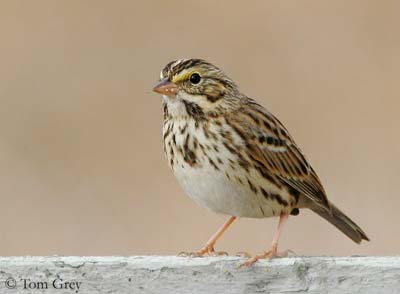
BEHAVIOUR:
Of the 17 recognized subspecies, six are resident or partially migratory in salt marshes in California and Mexico. Migrations occur mostly at night.
Savannah Sparrow feeds mostly on the ground, generally alone or in small flocks in winter. It runs and walks in open country, to forage, but it also forages in shrubs and small trees.
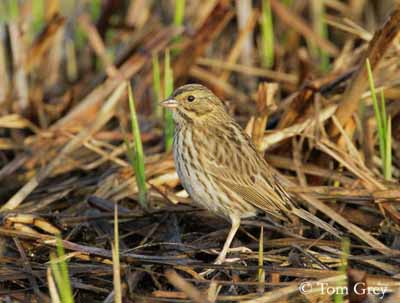
It returns to its same natal or breeding site each year. The male sings to defend nesting territory and to attract a mate. It often establishes a territory. During boundary disputes, males may assume a face-to-face threatening posture, or they may walk together, side by side, along their common boundary.
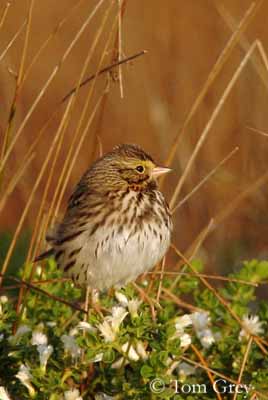
FLIGHT:
When disturbed by humans, Savannah Sparrow will take a short flight only far enough to dive back into the grasses and be hidden from view. But it prefers to run under vegetation and through the grass to disappear.
REPRODUCTION:
Savannah Sparrow’s nest is located on the ground, usually hidden among grass or weeds, and placed under matted dead plants, or overhanging grass. So the nest can only be approached through a tunnel from one side. It is built by female. It is an open cup made of grass, and lined with finer grass.
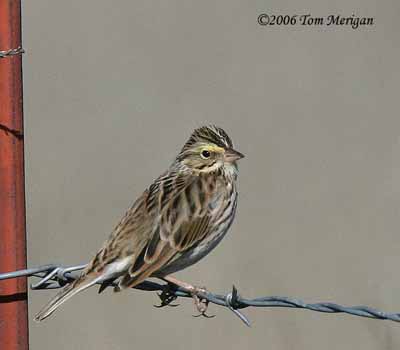
Female lays 2 to 6 eggs. They are whitish to pale tan or greenish, with brown markings at the large end. Incubation lasts about 10 to 13 days, by female. Both parents bring food to the nestlings. Young leave the nest about 8 to 11 days after hatching.
They may have 1 or 2 broods per year.
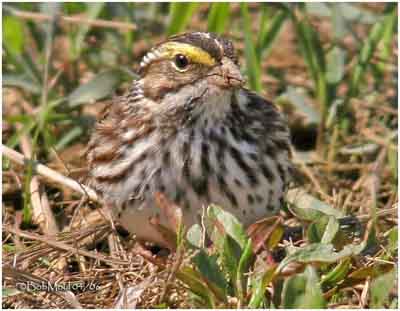
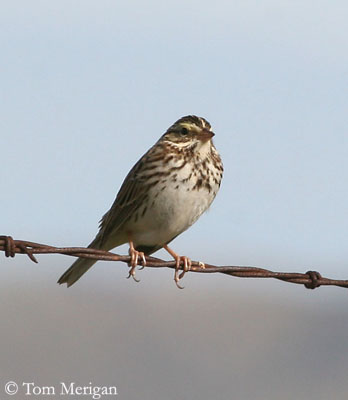
DIET:
Savannah Sparrow feeds mostly on insects, such as beetles, grasshoppers, caterpillars, flies, spiders. Coastal birds may eat tiny crustaceans and molluscs. They also eat many seeds, mainly from grasses, weeds, and some berries.
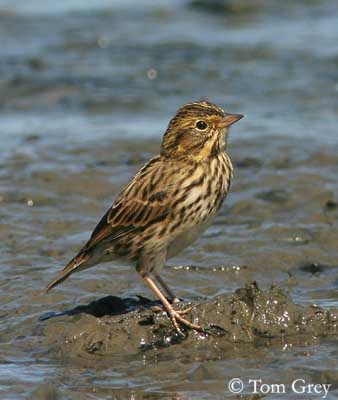
PROTECTION / THREATS / STATUS:
Savannah Sparrow is threatened by urbanization and reversion of farm fields to forest. These fields are suitable breeding habitat, but they are the first areas to be developed, or to return to forest. Also, the early mowing before mid-July results in a high percentage of nests failures.
Savannah Sparrow foods for some larger birds, such as the northern harrier, and because nests are often on the ground, snakes are common predators for eggs and nestlings.